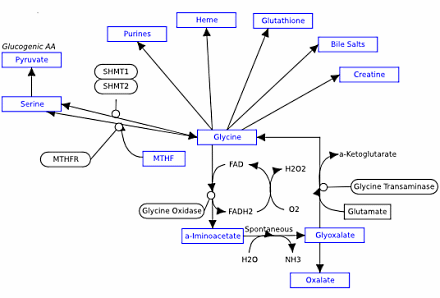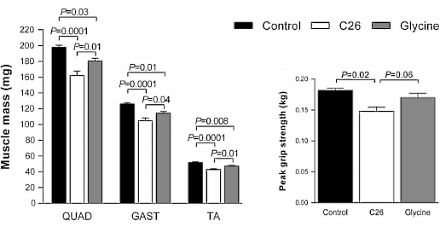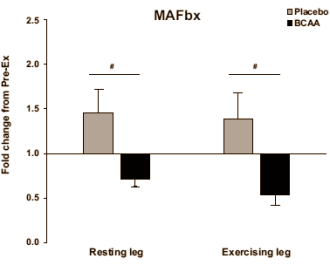|
The anticatabolic effect of glycine
Sports food manufacturers do nothing with the amino acid glycine. To them glycine is at best a pricey filling agent. But this image is not justified, according to an animal study that physiologists at the University of Melbourne published in Clinical Nutrition. According to their study, glycine has an anticatabolic effect.
Glycine
The figure below summarises what we know about the way the human body metabolises glycine. Glycine functions as a raw material for bile salts, purines, glutathione and even glucose, and can be created from other amino acids.

Less well known is that glycine inhibits inflammatory processes [Curr Opin Clin Nutr Metab Care. 2003 Mar;6(2):229-40.] and protects muscle tissue from withering when the blood circulation falters. [Curr Pharm Des. 2006;12(23):2953-67.] Because of these effects, the Australian researcher Daniel Ham wondered whether glycine might help against cachexia: the catabolic processes that arise in advanced forms of cancer.
Study
Ham injected mice with aggressive tumour cells, and then gave the animals daily glycine injections. Glycine is also easily absorbed orally, so there would be no objection to administering it mixed with food. But Ham used injections to get round the problem of reduced appetite as a result of the cancer.

The daily dose was 1 g glycine per kg bodyweight. Converted to adult humans that would amount to 7-10 g glycine per day.
Results
Administering glycine protected the muscle mass from breakdown and prevented a decline in muscle strength, Ham observed after three weeks.

Glycine supplementation inhibited the activity of catabolic genes such as Atrogin-1 in the muscles.
Ham repeated his experiments with the amino acids alanine and citrulline. These did not offer the muscles any protection. Glycine also inhibited the growth of the tumours and neither of the other amino acids had that effect. Citrulline actually speeded up the growth of the tumour.

Conclusion
"Regardless of the specific mechanism, glycine represents a potential treatment for cancer cachexia, either in isolation or in combination with other nutrients", the researchers conclude. "Glycine provides protection against cancer-induced reductions in skeletal muscle size and function, reduces the oxidative and inflammatory burden, and reduces the expression of genes associated with muscle protein breakdown in cancer cachexia."
It's just possible that glycine would have similar effects in athletes. Perhaps pre-workout products containing – for example – glycine and BCAAs could do interesting things for bodybuilders' progression.
Source:
Clin Nutr. 2014 Jun;33(3):448-58.
More:
The best high-protein slimming diet contains lots of taurine and glycine 13.04.2014
Glycine boosts reaction time with lack of sleep 19.02.2013
Improve your sleep with glycine, and your memory will work better too 18.02.2013
Archives:
Amino Acids
Glycine
|








